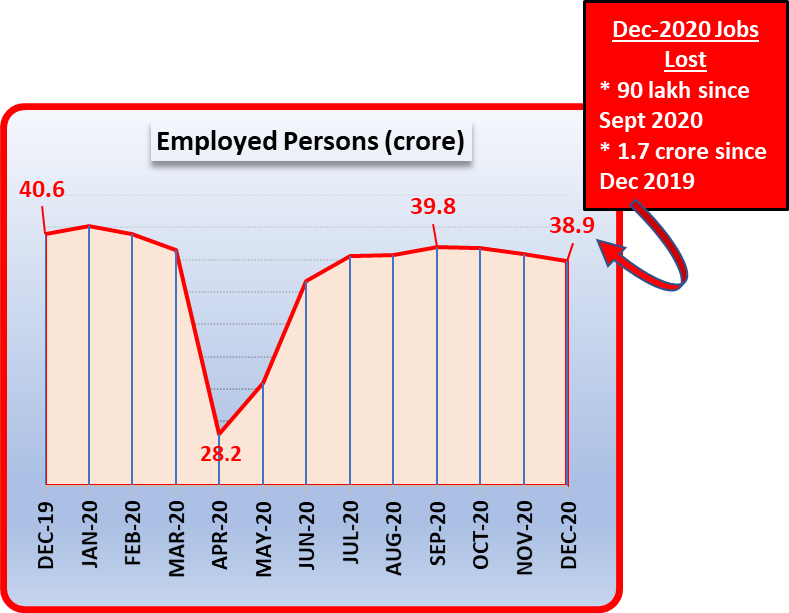India Faces Grim Jobs Crisis: 1.7 crore Jobs Lost in Past Year
There is a big hole in the celebratory chatter about India’s ‘economic recovery’ after the easing of lockdown restrictions. Compared with December 2019, over 1.7 crore (17 million) less persons were employed in the country, according to latest estimates from Centre for Monitoring Indian Economy or CMIE’s surveys. Since September 2020, the total number of employed persons dipped from 39.8 crore to 38.9 crore, indicating that 90 lakh (9 million) persons lost their jobs in three months. [See chart below]

In fact, the third quarter (October-December) of the 2020-21 saw employment go down by 2.8% compared with last year. This was more than the 2.6% contraction in the second quarter following the massive slump in the first quarter, which included the complete lockdown period.
The unemployment rate in December 2020 was 9.1%, up from 6.7% in September, and from 7.1% in December last. There has been a big jump in urban joblessness in December, from 6.2% in November to 9.2%.
Young, Educated, Salaried Bore the Brunt of Job Losses
This grim situation has murkier depths. A breakdown of job losses in the past year across various demographic sections shows that more jobs have been lost in urban areas, among younger workers, among women and in the salaried employees, CMIE’s analysis shows. Women’s employment was always a bottleneck in India and it appears that in the past year, women have borne the brunt of the lockdown-cum-economic downturn induced unemployment. Although they make up only 11% of the workforce, 52% of all job losses were among women.
The other demographic and economic categories are precisely those that used to be considered engines of jobs growth. Among younger people, job losses in the below-40 years age group were estimated at a mind boggling 2.17 crore (21.7 million) compared with 2019-20. Within this, those in the 30-39 years age group seemed to have suffered the most with 48% of all job losses being concentrated among them, although they make up only 23% of the country’s workforce. Above 40 year-old workers and employees gained about 72 lakh jobs (7.2 million) in the same period.
Salaried employees make up an estimated 21% of total employment but they were blindsided by a whopping loss of 71% of their jobs in the past year. Similarly, those with high education (graduates and post-graduates) make up only 13% of total employment but 65% of them lost their jobs. CMIE estimates suggest that some 95 lakh (9.5 million) of these highly educated persons lost their jobs.
Precarious Nature of Jobs
What remains then? It is India’s vast and variegated informal workforce in agriculture as well as other sectors that has managed to somehow survive and be ‘employed’. That’s because they have no other option – they have no savings, no security net and they were in any case living on very low wages earlier. They suffered the most during the lockdown, because the government refused to provide any income support and their jobs had vanished in thin air after the sudden announcement of the lockdown. But ironically, because of their very precarious situation, they were forced to find some work, whatever the wage/earning from it. Many of these were absorbed in agriculture, first during the kharif harvest and then during the rabi sowing.
What this means is, as CMIE points out, that the very nature of India’s workforce has shifted – for the worse. Prevalent forms of employment are less paying and more insecure than earlier, the younger persons are not finding jobs, women are not finding jobs and irregular incomes (rather than salaried jobs) have become more prevalent.
Worse to Come
Is this only because of the pandemic? All signs pint to the inescapable and bitter truth that in an already sinking economy, the blind and callous refusal of the Narendra Modi government to spend money in order to put buying power in the hands of common people and thus create conditions for expansion of the economy is the main reason for this devastating turn of events. The ill-conceived and mismanaged lockdown contributed to this. The government’s obsession with providing tax breaks and other concessions to corporate sector also heightened this crisis.
The worst part of this is that the government, far from learning the lesson and mending its ways, has doubled down to give even more of this poison to the country’s fragile economic system. Its dogged pursuance of privatisation of public sector, and its rigid resistance to take back the new farm laws are examples of this folly. All this put together points to only one direction – there is more misery on the cards for India’s people. Unless, the government is forced to change course, which is what the valiant farmers of the country are trying to do.
Get the latest reports & analysis with people's perspective on Protests, movements & deep analytical videos, discussions of the current affairs in your Telegram app. Subscribe to NewsClick's Telegram channel & get Real-Time updates on stories, as they get published on our website.
























